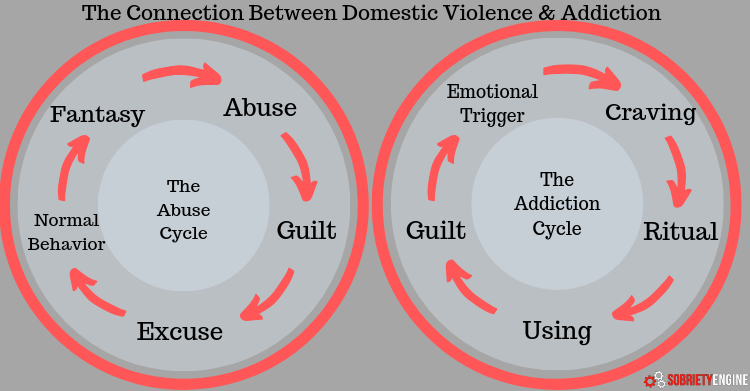Aug 8, 2019 | By Tim Stoddart
The Connection Between Domestic Violence and Addiction
Addiction Resources
Domestic violence affects millions each year. It’s defined as a pattern of behavior in a relationship that’s used by a partner or a spouse to maintain power over their partner, causing physical, sexual, and psychological harm. Though, it can also be associated with stalking, homicide, mental illness and suicide. Regardless of race, gender, sexuality, and religion, anybody can be effected by domestic violence, and there are many types of violence and abuse. Some can include:
- Physical
- Mental
- Financial
- Sexual
- Elderly
However, what about domestic violence and addiction? When combined with drugs, alcohol, and substance abuse disorder, domestic violence can escalate to an even more dangerous situation than it was previously.
Domestic Violence and Addiction
While domestic violence and addiction may have two separate distinctions, there is a correlation between the two. The Journal of Studies on Alcohol and Drugs found that before seeking treatment for substance abuse, the rate of violent acts was as high as 72 percent among men and 50 percent among women. Additionally, the Journal of Substance Abuse Treatment found that more than 75 perfect of individuals who started treatment for addiction reported having performed various acts of violence, including mugging, physical assault, and using a weapon to harm another. Researchers also found that aggression between two people in an intimate relationship were associated with heavy drinking and cocaine use.
According to the Centers for Disease Control and Prevention (CDC) each minute an average of 20 people are physically abused by a partner in the United States. That’s more than 10 million people per year. Additionally, being a victim of domestic violence can lead to substance abuse and addiction. In fact, women who have been abused are 15 times more likely to abuse alcohol and 9 times more likely to abuse drugs.
While prolonged abuse can cause victims to develop health problems such as behavioral health disorders, eating disorders, and mental health issues, substance abuse is often a maladaptive behavior to cope with the emotional aspects of abuse. According to the American Society of Addiction Medicine, research shows both victims and abusers are 11 times more likely to be involved in domestic violence incidence during heavy alcohol or drug use.
Causes of Domestic Violence and Addiction
While domestic violence and addiction don’t just happen, there are many factors that can contribute to the develop them. Whether it be biological, psychological, or socially driven, anger and deep seeded trauma can grow and ultimately these people can look for unhealthy ways to release anger. Some of these factors can include:
- Mental issues – Numerous mental health issues can lead to substance abuse issues and domestic violence due to the mental health of the perpetrator. In this situation, the person is not able to differentiate what’s right from wrong.
- Victims of abuse – Children who witness or who are victims of violence may turn to substances later in life. They may also learn to believe that violence and abuse is an acceptable way to resolve conflict between people.
- Low Self-Esteem – Those who are perpetrators may have extremely low-self esteem, extreme jealousy or difficulties in regulating their anger, or when they feel inferior to their partner in any type of background including socioeconomic and education. This can inhibit low self-esteem and also lead to substance abuse.
- Trauma – Past horrific experiences and unresolved trauma such including PSTD can lead to domestic violence and substance abuse. Many cope with trauma in a multitude of ways and maladaptive behaviors such as trauma ands domestic violence can develop over time.
Signs of Domestic Violence
Thought symptoms of domestic violence can be far reaching, for victims other than perpetrators, symptoms may be easier to see. If you have a family member or loved one that is being abused, it’s may not be easy for them to admit they’re being abused and there are multiple reasons that these people continue to stay in their relationships including the fear of safety for their children, or the concern of feeling guilty if they say something and their abuser is the primary breadwinner. In other cases, victims may also be afraid of experiencing the unknown. No matter the situation, it’s important for loved ones to understand the symptoms and reasoning behind their behavior.
With a family member or loved one, some symptoms may include:
- Low self-esteem
- Showing signs of depression, anxiety.
- Skipping out on important events such as work, school, or social engagements
- Blaming themselves for arguments and altercations with their partner
- Minimizing arguments and altercations with their partner
- Telling stories of accidental injuries to explain bruises
- Making excuses to stay with their partner and justifying their behavior
- Acting nervous around their partner
- Describing their partner or spouse as jealous or possessive
Why Don’t Victims Get Help?
Many face obstacles in getting help, which can make it hard to end a violent relationship. The single most common barrier is that they failed to realize they were in an abusive relationship due to their partner portraying their behavior as ‘normal.’ Most ultimately don’t know who or where to turn because they don’t understand domestic violence and addiction and how they correlate.
Other types of obstacles include social stigma, fear of arrest, fear of not being loved if in an intimate relationship, and blaming themselves. Other barriers include being social isolated, the fear of their perpetrators revenge, or loss of child custody. In addition, victims also fear that if they talk about the abuse out loud, it will make things worse and lead to more violence or abuse.
This in turn, leads to the cycle of abuse, which can ultimately create a cycle of addiction. The cycle of abuse can be all encompassing and each stage can also accompany a stage of addiction. As a circle never ends, the cycle keeps going, until an intervention has occurred. The abuse cycle is similar to the addiction cycle in that the guilt the victim or user feels permeates the continued negative coping skills. A diagram is as follows:

Is Addiction To Blame For Domestic Violence?
While there’s concrete evidence between domestic violence and addiction that indicates regular substance abuse is the highest leading risk factor to violence in a intimate relationship, experts and researchers do indicate that it is not the sole cause of violence. According to the U.S. Department of Justice, 61% of offenders of domestic abuse abuse substances and over 50% of spouses accused of murdering their spouse were under the influence of drugs or alcohol on the day of murder.
While stated, it is not the only factor of domestic violence, drug and alcohol abuse do create a higher tendency for someone to be violent. Adversely, studies indicate that potentially violent situations are more dangerous when the victim is the substance abuser because the victim is less able to accurately assess imminent danger and flee or may exacerbate the situation.
Victims of domestic violence and addiction also commonly do not report their assault due to fear of prosecution for use and the fear of being the victim of repeated violence. Beyond that, 51% of addiction program managers have stated that a woman’s addiction may prolong her from leaving an abusive relationship, leading to greater physical, emotional, and psychological consequences and repeated assaults. Typically, the failure to leave an abusive relationship can lead to heightened violence, and many times result in the death of the victim.
Treatment for Domestic Violence and Addiction
It’s especially important for those who are suffering from domestic violence and addiction to treat both simultaneously, addressing the underlying cause of the addiction to leave the abusive relationship, and ultimately create sustainable recovery.
There are many specialized treatment programs for victims of domestic violence and addiction with professionals who are educated and equipped to meet the special needs of this demographic. Most facilities provide a safe, confidential space for those in need of addressing private and important issues inherent to gaining optimal health. Those in need of treatment can also find government resources and support groups for victims of domestic abuse.

Lisa Barrett-Gerardi
4 years ago
I believe all of this I grew up in a environment like this my father is an alcoholic and drug addict or was he abused both of his wives and his wives both showed all these symptoms. Fortunately both my moms didn’t need the help they were strong enough to kick him out of their lives after a long 11?yrs I guess you can say that was his unlucky #. I truly hope anyone who is going through this gets the help they need to get out of the relationship and live a happy life that they deserve